Day 1 - Monasteries Route
On this route you will visit the monasteries located further from the rivers in Ribeira Sacra. This is one half of a 2-day route that lets you visit all of the existing monasteries in Ribeira Sacra.
The day begins with a visit to the Monastery of San Pedro de Rocas. This is the oldest monastery in Galicia, and it is also notable because it has been excavated into the natural stone. Here you can visit the cave church, the anthropomorphic tombs carved into stone, the miraculous spring of San Bieito, and the Ribeira Sacra Interpretive Centre. This is an excellent starting point, because the Ribeira Sacra Interpretive Centre is inside this monastery. It has an exhibition space that will help you get oriented and learn about some of the essential characteristics of Ribeira Sacra, the traditions of its local people, and life in its monasteries.
After visiting San Pedro de Rocas, you will travel east on OU-536 to the Monastery of Santa María de Xunqueira de Espadanedo, which is located in the town with that name. With a guided tour (you need to book your visit in advance at https://turismo.ribeirasacra.org/en/reservas), you can learn about all the unique characteristics of this undiscovered treasure of Ribeira Sacra.
Next, return to the OU-536 and just after you pass through the village of Vilariño Frío, turn right onto OU-0602 to travel in the direction of Montederramo. Your next stop, the Monastery of Santa María de Montederramo, is located in the centre of that town (here too, you need to book your visit in advance at https://turismo.ribeirasacra.org/en/reservas). Most historians attribute the origin of this monastery to a document issued in the year 1124 by Teresa, Countess of Portugal, in which the name Ribera Sacra first appears.
To reach your next stop, return to OU-536 and turn right to travel in the direction of Castro Caldelas. When you reach that town, turn left onto LU-903 and follow the signs to travel in the direction of Doade. When you get to the village of A Abeleda, you will turn right to reach your next stop, which is the As Penas de Matacás Viewpoint. This viewpoint offers an impressive panoramic view over both banks of the Sil River. You will see how the south bank is covered by leafy forests, while examples of the famous terraced vineyards are cultivated on the north bank.
After this, return to the LU-903 highway and turn right, to continue in the direction of Doade. The road will lead right down to the river, until reaching the boat docks you were able to see from the viewpoint. The road then rises again to approximately halfway up the other riverbank, where you can stop at the Soutochao Viewpoint. Here you will get a closer look at the vineyards, and you will discover why this form of grape cultivation is referred to as “heroic viticulture”.
After stopping at the Soutochao Viewpoint, you will continue to the next stop on this route, which is the Monastery of San Vicente do Pino. To do this, you will continue on the same highway you were on before, travelling in the same direction. When you arrive in Monforte de Lemos, at the first large roundabout continue straight ahead, following the signs indicating the Parador hotel ("PARADOR").
The Monastery of San Vicente do Pino is now one of the two hotels in Ribeira Sacra belonging to Spain’s Parador network. This monastery is located on San Vicente Hill, which is the city’s highest point, so the monastery’s location also provides an excellent viewpoint over Monforte de Lemos. The monastery is also part of the San Vicente do Pino Monumental Complex, which includes the Castle’s Keep as well as the Count’s House (Casa Condal), which was owned by the local landlords, the historic Counts of Lemos.
COMMENTS
- Based on the guidelines for how much time to spend at each location, and if you begin the route at the time when the Monastery of San Pedro de Rocas opens to visitors (10.30 a.m.), then the times to book your visits at the Monastery of Xunqueira de Espadanedo and Monastery of Montederramo should be 12.00 p.m. and 1.00 p.m., respectively.
OTHER INFORMATION OF INTEREST
 WHERE TO EAT · Click here to find the restaurants that are closest to your location at any time (the list can be filtered by municipality).
WHERE TO EAT · Click here to find the restaurants that are closest to your location at any time (the list can be filtered by municipality).
 MORE ATTRACTIONS · If you want to complement your itinerary with other attractions close to your current location, use the interactive map. Using the search feature, you can select the municipality where you are located (we recommend this option only during times of the year when there are extra daylight hours).
MORE ATTRACTIONS · If you want to complement your itinerary with other attractions close to your current location, use the interactive map. Using the search feature, you can select the municipality where you are located (we recommend this option only during times of the year when there are extra daylight hours).

The monastery of San Pedro de Rocas is located in the hill Barbeirón, surrounded by rock formations that might have given a name to this place.
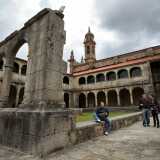
This monastery is one of the most unknown in the Ribeira Sacra, and certainly offers many elements that make it worth visiting. Moreover, throughout its history it has passed through many architectural styles, from Romanesque to Baroque.
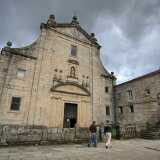
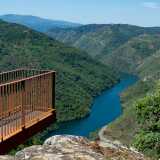
The lookout point is at an altitude of over 500 metres and is, as its name suggests, situated on the Peñas, or rocks, of Matacás. From here there are some impressive views of the Sil Gorge.
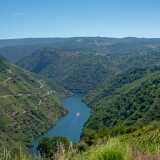
This viewpoint stands among vineyards that grow on steep slopes, hundreds of metres above the waters of the river Sil. At the entrance to the lookout point is a huge granite statue dedicated to the grape pickers of the area.
 The group of viewpoints of the Sober City Council, including this one, obtained the seal of Tourist Quality of Spain (ICTE). Only five public spaces of this type, in the whole of Spain, have obtained this label until 2021.
The group of viewpoints of the Sober City Council, including this one, obtained the seal of Tourist Quality of Spain (ICTE). Only five public spaces of this type, in the whole of Spain, have obtained this label until 2021.
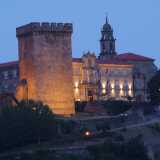
Above the plain of Monforte de Lemos rises a small hill which overlooks its entire expanse. This was the site chosen in the 10th century for building what would subsequently become the current monastery. It is also said that this was the location for the well-known Castrum Dactonium, of the Celtic Lemavos tribe, mentioned by the historians Ptolemy and Pliny the Elder.
Don't miss!
On this route you can add a catamaran boat trip on the river just after lunchtime, which you can take from the boat docks at Abeleda or Ponte do Sil. In the same area, you can also enjoy activities such as the wine tourism train or a visit to a winery. However, to include either of these activities during times of the year with fewer daylight hours, you will have to eliminate at least the first of the viewpoint stops.

 What would you improve?
What would you improve? 